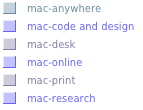Merlin’s weekly podcast with Dan Benjamin. We talk about creativity, independence, and making things you love.
Using Categories & Tasks in Entourage
Merlin Mann | Feb 14 2005
Still, it’s important to me to strike a balance even when I’m planning and processing: how do I touch each item as quickly and infrequently as possible while still ensuring that it pops up when and where I might need it later? For me this usually means applying only one Category per item and changing it later if the need arises. I mean, for example, I know I need to be online in order to send an email, but I don’t want to get bogged down in trying to describe every conceivable facet of the task with the finest granularity. (Keep repeating: "GTD is about action; it’s not about playing with lists.") Also, as I’ve said before, I’ve found context to be one of the most challenging aspects of implementing GTD—especially because, on some days, my contexts feel limited to "computer" and "everyplace else." Still, getting contexts right for your unique situation can be critical to succeeding with GTD. If you’re struggling to think about what you should be doing next, something’s not working. For "next actions" to have the kind of brain-dead physical simplicity we all crave, they need to be situated in a way that lets you take them up wherever you are and without a constant level of meta-thinking about "whether this is in the right place." All that said, here’s an overview of the Categories I use most when processing, filtering, and doing the items on my task list (currently ~150 items). Your mileage will absolutely vary. Functional Categories
Computer-Related CategoriesAgain, I know that many of these imply nesting; for my own system, I can live with that. I only want to tag an item with the Category that best represents its context (there's no manageable system that can do all the thinking for you). These sub-categories are still much more helpful to me than a generic "@computer"—that’s about as useful to me as "@breathing" or "@NorthAmerica."
Other Contextual Categories
Non-Contextual CategoriesThese are oddballs. A couple of them are GTD-inspired, but I think they all represent potential action down the road. Consequently, I filter them out of most action list custom views, and just review them separately every week or so. I think it’s important to add that many of the tasks tagged with the Categories "maybe-later" and "waiting" actually began life as a regular, functional todo I’d given myself, but later got retagged/downgraded to be one of these temporarily disowned items.
So that’s a quick look. I hope some of it is useful for you, but more importantly, I hope it helps you undertake a deeper look at how you organize and plan your work. To understand your work and not have it overwhelm you, I think it helps to grok where and when you can actually perform the constituent tasks. Getting your contexts wrong can mean a lot of frustrating list management and dropped balls, but knowing with confidence that your tasks are assigned appropriate contexts can be a huge timesaver and a big load off your brain. What special contexts do you use to keep items on your radar screen? Any novel Categories you're using in your PIM? (Nota bene: Fellow Entourage fans, be sure to tune in later this week for a post on the least utilized and most misunderstood feature in Entourage—custom views. GTD-friendly recipes await you.) Related links 21 Comments
POSTED IN:
 I've taken to prepending an...Submitted by jmb (not verified) on February 14, 2005 - 6:58pm.
I've taken to prepending an '@' in front of all the categories that I use for tasks. Since there's some overlap between task categories and contact categories, I have some near duplicates -- e.g., 'work' and '@work' for people I work with and tasks that need to be done at work. I've also subcategorized things that I'm waiting on into '@waiting-home' and '@waiting-work'. I also drop these items to lowest priority to get them to fall to the bottom of the task list and out of the way (but still in sight). But I digress... The use of the @ sign (or any other symbol) helps a lot, as it causes my task categories to sort out separately from the rest. » POSTED IN:
|
|
| EXPLORE 43Folders | THE GOOD STUFF |
 Categories are a powerful tool for organizing any of the information you store in
Categories are a powerful tool for organizing any of the information you store in 